
2023-2024



2023-2024

Saving Northeast Texas 2023-2024 provides an overview of Preservation Texas’s Most Endangered Places listings in the Northeast Texas region, as well as useful information about Preservation Texas and how you can work to protect cultural and historic sites where you live.
Preservation Texas is a private, 501(c)(3) nonprofit organization, founded in 1985 and headquartered in San Marcos. The organization receives no public funding and relies on membership dues, grants and donations for its work. A volunteer Board of Directors, drawn from a range of professional and community backgrounds governs the organization and provides direction to staff.
The chartered purposes of the organization are broad and intended to enable a range of preservation activities:
• To serve as an auxiliary to all agencies of the State of Texas concerned with our history, heritage, and the preservation and maintenance of significant areas, sites, buildings, monuments and artifacts;
• To acquire, by purchase, gift, devise or bequest, with or without restriction, and to preserve, restore, maintain and present to the public those areas, sites, buildings, monuments, artifacts, documents, and objects which are significant in the history, prehistory, archaeology, architecture, heritage and culture of Texas;
• To disseminate knowledge of the history, prehistory, heritage and culture of Texas;
• To engage in historical and archaeological research on the activities of past Texans; and
• To foster, encourage and develop a general appreciation and understanding of the
accomplishments of past generations of Texans in order that the lives of present and future generations may be enriched.
The organization fulfills its mission through (A) Legislative Advocacy by alerting its members to important legislation being considered by the State of Texas and providing written and oral testimony at bill hearings; (B) Local Advocacy by intervening on behalf of local stakeholders who ask for support from Preservation Texas;
(C) Educational Programs such as the biennial Preservation Day at the Capitol and regional symposia on historic preservation topics; (D) Honor Awards that recognize outstanding preservation efforts to save Texas’ Most Endangered Places; and (E) Preservation Texas’s signature Most Endangered Places List program, begun in 2004; more about this program will follow (see page 8).
Preservation Texas also owns Bassett Farms Conservancy, a 2,400-acre working cattle ranch and former cotton farm located southeast of Waco in Falls and Limestone counties. The Conservancy is being developed as a preservation and conservation training center and retreat. Founded in 1871, the farm and ranch was bequeathed to Preservation Texas in 2011 by the late Mrs. Willie Ford (Bassett) Sparkman, and includes a range of historic, cultural and natural resources. Programs will focus on developing historic preservation skills, while the property is to be managed with a focus on cultural landscape preservation.
In 2022, Preservation Texas’s Board of Directors agreed to move to a regional office model for the delivery of preservation education and technical assistance programs.
Conor Herterich is Preservation Texas’s Northeast Texas Program Officer. Based in Tyler, Conor serves as a first point of contact for

members and stakeholders within a 41-county region of Northeast Texas. This position has been made possible by the generous support of The Summerlee Foundation and the Dealey Family Foundation (see page 20).
This section provides an overview of programs and resources that can be useful in protecting historic places.
Historic places may be officially recognized as historic by federal, state and local governments. These designations serve a range of purposes; some tied to incentives and some tied to regulations. Just because a site has not been designated does not mean that it lacks significance; more than likely, no effort has yet been made to recognize it as almost all such designations are initiated at the local level by property owners, advocates, historical societies, preservation organizations or historical commissions.
Efforts to save sites are often more successful when the buildings have federal- or statelevel designations. These designations give assurance to decision-makers, grant- funders and the general public that a site has welldocumented significance. Therefore, a plan to secure designation should be put in place for any endangered resource that is not yet designated.
The regulatory effects of designation vary. Federal designation provides no regulatory oversight of historic places; state designation provides a range of limited (Recorded Texas Historic Landmarks) to strong (State Antiquities Landmarks) oversight. Maximum oversight is typically found at the local level through the designation of local landmarks and local historic districts, although some local ordinances are weak and ineffective.
The Texas Historical Commission’s Texas Historic Sites Atlas enables you to search for specific buildings and to see all of the sites recognized at the state and federal levels. Be sure to verify the information in the Atlas by contacting the Texas Historical Commission as no database is perfect. The website is: Atlas.THC.State.tx.us
The National Register of Historic Places was created in 1966 under the National Historic Preservation Act. The process begins with submission of a comprehensive nomination form to the Texas Historical Commission. The submitted form is then reviewed by the State Board of Review before being forwarded to the National Park Service for final approval. In Texas (2023) there are 3,615 listings on the National Register, of which 1,671 are Historic Districts.
National Register properties are evaluated for the quality of their significance and must possess integrity of location, design, setting, materials, workmanship, feeling and association. They must be associated with significant events or significant people, embody a distinctive architectural type, period, method of construction, the work of a master, artistic value, or be likely to yield important information in history or prehistory. Cemeteries, birthplaces, graves, commemorative properties and relocated structures are typically not listed, but there are exceptions.
Individually listed buildings and sites that are added to the National Register are classified as being of local, statewide or national significance. Typically, but not always, these buildings must be at least fifty years old. The Texas Historical Commission can assist in determining whether an unlisted building might be eligible for listing

before a formal nomination is submitted.
Cohesive areas or neighborhoods may also be listed on the National Register as Historic Districts. A majority of the properties within a historic district must have historic significance and retain their historic character — such properties are known as contributing properties. Contributing properties are afforded the same grant opportunities and incentives as sites that are individually listed.
For a site of exceptional significance, the National Park Service will very selectively consider nominations for its designation as a National Historic Landmark, a specific category that recognizes sites of special importance to all Americans. Thus the use of the phrases “listed on the National Register” and “historic landmark” are not interchangeable. Federal programs treat National Historic Landmarks somewhat differently because of their status, including greater protection if a federal project threatens to impact the site, or access to grants such as the Save America’s Treasures grant program.
Federal designation comes with no regulatory oversight by the federal government. The National Park Service plays no direct role in the planning, management or any other decision-making related to sites listed on the National Register of Historic Places. However, sites listed on the National Register or contributing to a National Register Historic District may be eligible for the 20% rehabilitation tax credit.
The Texas Historical Commission reviews and approves nominations for buildings to be designated as Recorded Texas Historic Landmarks (RTHLs). These Landmarks must be at least fifty years of age or older and retain architectural integrity. Buildings cannot become
RTHLs if historic features are obscured by nonhistoric materials, such as vinyl siding, or if they have been relocated within the last fifty years.
Nominations are submitted through the local County Historical Commission. Sites that are designated as RTHLs are recognized with Official Texas Historical Markers. It should be noted, however, that just because a building or site has a state marker does not mean that it is an RTHL. There are over 16,000 Official Texas Historical Markers; of those only about 3,800 are RTHLs. If a building or site is an RTHL, its marker should have “Recorded Texas Historic Landmark” stamped at the bottom.
A limited amount of protection is afforded by the RTHL designation. The historic or architectural integrity of an RTHL shall not be altered without notifying the Texas Historical Commission at least 60 days in advance. Interiors are not regulated unless the changes impact the exterior or the structural integrity of the building.
State Antiquities Landmarks (SALs) are designated by the Texas Historical Commission and are protected under the Antiquities Code of Texas. Any building listed on the National Register that is located on non-federal public land (state, county, or city) is eligible for designation. Sites can be nominated by any group or individual, and are considered by the Antiquities Advisory Board before a final vote by the Texas Historical Commission.
The SAL designation is the most restrictive state-level designation available as it requires the property owner to consult with the Commission to determine if proposed alterations or demolition can occur. Archaeological sites may also be designated as SALs but do not need to be listed on the National Register.
The Historic Texas Cemeteries program began

in 1998. Cemeteries receiving this designation are protected by a record of their boundaries in county deeds and future owners of adjoining land are alerted of its existence. However, the designation provides no regulatory oversight over the property. Other state laws govern the handling of human remains and cemeteries in Texas. Historic Texas Cemetery designation is required before applying for an Official Texas Historical Marker for a cemetery.
State law enables local governments to create local historic districts. These are typically, but not always, accomplished through zoning amendments, creating provisions that govern alteration and potential demolition of local landmarks as well as new construction within locally designated historic districts. There is no standard set of regulations or guidelines in use statewide. While many local preservation ordinances are similar, each one is tailored to suit the needs and objectives of the community. Some communities are better than others in making information about local landmarks and historic districts available online; be sure to contact the local preservation or planning official for current information about landmarks, historic district boundaries, and relevant regulations.
The Secretary of the Interior’s Standards are applied to almost every decision made at the federal, state and local level relative to proposed physical changes to a historic place. These Standards were established in 1977 by the National Park Service under the authority of the United States Secretary of the Interior and provide guidelines for Preservation (maintaining a structure as found); Restoration (uncovering, protecting and recreating features that would have been present during a specific period of
significance); Rehabilitation (protecting key character-defining features while modifying other parts of the structure for contemporary uses); and Reconstruction (rebuilding a known, lost historic structure using extensive historical documentation).
Museum properties and exceptionally unique structures are typically preserved or restored; buildings that are being put to new uses or that have lost much of their historic integrity are generally rehabilitated. Historically accurate reconstructions are uncommon and usually only undertaken for museum sites or minor outbuildings on private property. The standards encourage new construction to reflect contemporary aesthetics using compatible materials, form and scale.
Information about the Standards as well as Guidelines for the Treatment of Cultural Landscapes can be found at: NPS.gov/TPS/ Standards.htm
The National Park Service has published fifty Preservation Briefs that are available online at: NPS.gov/orgs/1739/preservation-briefs.htm . These briefs cover a range of specific topics from Repointing Mortar Joints in Historic Masonry Buildings (Brief #2) to Preserving Grave Markers in Historic Cemeteries (Brief #48). These technical briefs provide excellent illustrated examples to better inform property stewards about best practices.
Financial incentives are available at the federal, state and sometimes local level for historic preservation.

Federal historic preservation incentives are managed by the National Park Service in partnership with the Texas Historical Commission. Information can be found at: NPS.gov/subjects/taxincentives/index.htm
A summary of these federal incentives follows.
Income-producing historic buildings that are certified by the National Park Service as historic structures (typically those listed on the National Register of Historic Places) are eligible for a 20% income tax credit based on the qualifying costs of the project. Eligible properties include commercial, industrial, agricultural or residential rental properties.
The charitable donation of a historic preservation easement to a qualifying organization such as Preservation Texas provides additional tax benefits. An easement permanently protects a structure and its site by prohibiting changes to the exterior (and in some cases interior) features and by restricting land uses. These restrictions are voluntary and negotiated between the landowner and the donee organization within federal guidelines. The value of the donation is determined by a professional appraiser who considers the potential reduction of the market value of the property after the imposition of these voluntary restrictions.
Rehabilitations of large historic structures often make use of a combination of the 20% tax credit and the Low-Income Housing Tax Credit (LIHTC). The LIHTC is approximately 9% of the project cost, and provides an incentive for the creation of affordable rental housing for lowincome households.
The Texas Historic Preservation Tax Credit
became effective in 2015. It provides for a tax credit of 25% of qualifying project costs for the rehabilitation of buildings listed on the National Register of Historic Places, as Recorded Texas Historic Landmarks or as State Antiquities Landmarks. Only buildings are eligible, and they must be used for income-producing or non-profit purposes.
Government-owned structures do not qualify unless they have been leased, typically to a nonprofit organization for an extended term. Nonprofit organizations, despite not paying taxes, can sell their state tax credit. For example, a $100,000 church restoration may result in a $25,000 tax credit that can be sold by the church to a Texas corporation that pays the state franchise tax or state insurance premium tax. Tax credit brokers may also purchase a credit. The dollar value of the credit is negotiated between the tax credit certificate holder and the purchaser, typically somewhat less than face value.
Many local governments have adopted tax abatement or exemption programs to encourage the rehabilitation of historic structures, typically in historic downtown commercial districts managed by Main Street programs or in historic residential districts. Details about these local programs can be found by contacting the City Manager or similar official in the city in which a building is located. If your community does not yet have a local program, consider advocating for the establishment of such a program.
Federal, state and local historic designations for at-risk historic properties open the door to potential grants for restoration or rehabilitation. Grant funds are limited and highly competitive, and only significant historic places with urgent

preservation needs are usually awarded these grants. A summary of grant programs follows.
The most significant federal grant program is the Save America’s Treasures grant program. These grants are limited to National Historic Landmarks or buildings listed on the National Register of Historic Places at the national level of significance. Grants range from $125,000 to $500,000.
More widely used are Historic Preservation Fund grants, administered through the Texas Historical Commission’s Certified Local Government (CLG) program. These grants are available for historic resource surveys, National Register nominations, local preservation plans, local ordinance development or repairs in CLG communities. Grants range from $2,000 to $30,000. CLGs must meet federal standards with respect to their local preservation regulatory system; CLGs in Northeast Texas are:
• Corsicana (Navarro Co.)
• Dallas (Dallas Co.)
• Denison (Grayson Co.)
• Ennis (Ellis Co.)
• Longview (Gregg Co.)
• Marshall (Harrison Co.)
• Mineola (Wood Co.)
• Mount Vernon (Franklin Co.)
• Nacogdoches (Nacogdoches Co.)
• Palestine (Anderson Co.)
• Paris (Lamar Co.)
• Plano (Collin Co.)
• Rockwall (Rockwall Co.)
• Royse City (Rockwall Co.)
• San Augustine County
• Tyler (Smith Co.)
• Waxahachie (Ellis Co.)
The Preserve America grant program remains authorized by Congress but in recent years has
not received any federal funding. This grant program supported preservation planning activities in designated Preserve America communities. Preserve America communities in Northeast Texas are:
• Atlanta (Cass Co.)
• Canton (Van Zandt Co.)
• Clarksville (Red River Co.)
• Dallas (Dallas Co.)
• Farmersville (Collin Co.)
• Frisco (Collin Co.)
• Junius Heights Neighborhood (Dallas Co.)
• Marshall (Harrison Co.)
• McKinney (Collin Co.)
• Mesquite (Dallas Co)
• Mineola (Wood Co.)
• Mount Vernon (Franklin Co.)
• Nacogdoches (Nacogdoches Co.)
• Palestine (Anderson Co.)
• Paris (Lamar Co.)
• Pittsburg (Camp Co.)
• Plano (Collin Co.)
• Rockwall (Rockwall Co.)
• Sabine County
• Tyler (Smith Co.)
• Waxahachie (Ellis Co.)
• Winnsboro (Wood Co.)
Some grant funding through the U.S. Department of Agriculture may be available for the rehabilitation of historic structures, particularly those that will be used for community economic development purposes. The National Endowment for the Arts and National Endowment for the Humanities will sometimes have grant opportunities that apply to historic structures being used for the arts or for museum purposes. Visit grants.gov for more information about federal grant opportunities.

The Texas Historical Commission’s Texas Preservation Trust Fund supports historic site acquisition, survey, restoration, preservation, planning and heritage education relating to historic architecture and archaeological sites. These are competitive grants that can provide up to $30,000 in funding.
Preservation Texas played a leading role in the establishment of the Texas Historic Courthouse Preservation program. Since 1999, 74 historic county courthouses have received full restoration grants and another 29 have received emergency or planning grants (2023). The competitive program is administered by the Texas Historical Commission. Northeast Texas counties that have completed courthouse restorations through this program are: Cass, Dallas, Ellis, Fannin, Franklin, Harrison, Hopkins, Lamar, Leon, Marion, Navarro, Rains, Red River, and San Augustine.
Some nonprofit organizations and foundations offer grant opportunities that have been utilized to save endangered places in Texas.
The National Trust for Historic Preservation (SavingPlaces.org/grants) offers grants through its Preservation Fund; additional grant programs for historic African-American places and for Sacred Places have recently been initiated.
The Texas Historical Foundation ( TexasHistoricalFoundation.org ) provides grants of up to $5,000 that have been used for restoration projects. The Summerlee Foundation based in Dallas has also provided extensive grant funding for preservation projects across Texas. Regional community foundations are also an important source of donor-directed grants that might be available for historic preservation projects.
Historic structures in railroad communities have benefited from grants by the BNSF Railway Foundation (BNSFFoundation.org ) or the Union Pacific Foundation (UP.com) depending on which rail line operates in the community.
Grants for building materials for small projects have been awarded by the Home Depot; big box building supply stores will sometimes donate materials and equipment with a letter submitted to the store manager.
Financial institutions that serve the community often have grant programs. Some may be directed by local branch managers; others require application to the bank’s national headquarters.
For many people working to save a historic place, the role of different government agencies and organizations can be confusing. Each plays an important but specific role. Understanding what these agencies and organizations can (and can’t) do will help you chart a course for action.
The National Park Service (NPS.gov) is the principal federal agency governing historic preservation programs. Most importantly, they oversee the National Register of Historic Places and the federal tax credit program.
The Advisory Council on Historic Preservation (ACHP.gov) is a small, independent federal agency that promotes historic preservation across the federal government. It advises the President and Congress on national preservation policy, with a special focus on implementation of the National Historic Preservation Act.

The National Trust for Historic Preservation (SavingPlaces.org ) is a private, non-profit organization that manages historic sites, intervenes in preservation lawsuits, manages the 11 Most Endangered List, and provides educational programming through its national conference. It is not a government agency and has no role in administering federal programs.
The national advocacy organization based in Washington, D.C. is Preservation Action (PreservationAction.org ), a 501(c)(4) nonprofit that works to develop historic preservation programs through advocacy for federal legislation in the U.S. Congress.
Another important organization is Partners for Sacred Places (SacredPlaces.org ), a nonprofit organization based in Philadelphia that supports stewardship of active congregations in older sacred places through capital campaign training and technical assistance.
The Texas Historical Commission ( THC. Texas.gov) is the state historic preservation office, based in Austin. As a state agency they administer state programs and act as a liaison for federal programs. With over 250 staff members, they provide assistance in a range of programs and also administer the state’s Main Street program.
Preservation Texas (PreservationTexas.org ) is the only statewide nonprofit historic preservation advocacy and education organization in Texas (Section 1.0).
Most Texas counties have established a County Historical Commission (CHC). These volunteer groups provide county-wide guidance to deliver educational programs, operate history
museums, and advise the Texas Historical Commission on historic marker applications, for example. Some CHCs are very active while others meet infrequently. The local CHC can be an important resource, particularly when seeking historic designations.
Local governments that have adopted preservation ordinances usually establish a historic commission, landmark commission or similarly named committee of volunteers. These commissions administer local preservation programs, including local landmark designations, approval of historic building permits, and the development of preservation plans for the community.
Local non-profit preservation organizations operate independently of the government and typically support advocacy and educational programs. Each organization is different; some administer historic sites, some do not. Examples in Northeast Texas include Historic Tyler and Preservation Longview. City-focused organizations often provide assistance to smaller communities within their counties.
Established in 2004, Texas’s Most Endangered Places List is the signature program of Preservation Texas. Over the last eighteen years, over 170 sites and themes have been added to the list, of which less than 15 have been lost. The list is designed to provide statewide publicity for important historic places at risk of imminent loss. Sites are nominated to Preservation Texas by its members and selections are announced annually. Preservation Texas provides advocacy and technical support for these places when requested by local advocates.
A list of Northeast Texas sites that have been included on the Most Endangered Places List follows.

ADDRESS 2849 CR 2608, Tennessee Colony
DESIGNATION NRHP Eligible
CONDITION Fair
OWNER Bethel Baptist Church
RESOURCE TYPE Church
YEAR LISTED 2022
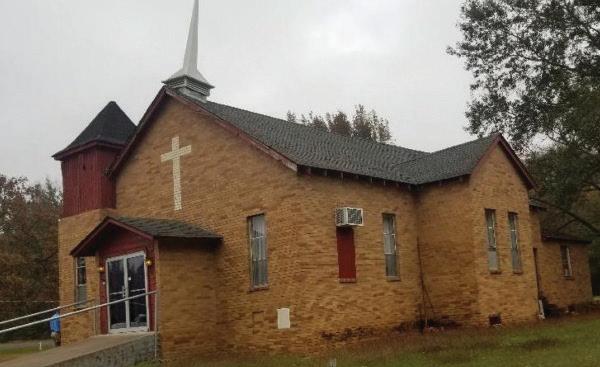
The Bethel congregation originally worshiped in a brush arbor near the present Jackson Quarters Cemetery. In 1872, after emancipation, they established a church at the current site. The present building was constructed around 1919 using materials salvaged from the first church on site, and was covered in a brick veneer in the 1970s. Though the church building remains in active use, the structure is in need of significant repair work. Bethel Baptist Church will receive a $75,000 grant through Preservation Texas’s Rural African-American Heritage Grants Program.
ADDRESS 913 E Calhoun St, Palestine
DESIGNATION NRHP, RTHL, Local Historic Landmark
CONDITION Fair
OWNER A.M.E. Church
RESOURCE TYPE Church
YEAR LISTED 2015
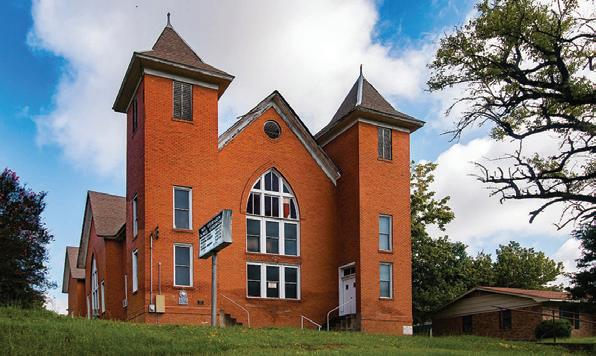
Mount Vernon A.M.E. Church was organized by freedmen in 1873. The present structure (1921) is a prime example of Gothic Revival architecture. Suffering major roof and structural damage, the church closed in 2013. Local preservationists have been working to raise money for a full restoration and re-opening. Mount Vernon will receive a $75,000 grant through Preservation Texas’s Rural African-American Heritage Grants Program.
ADDRESS 228 Leach Street, Lufkin
DESIGNATION NRHP Eligible
CONDITION Fair
OWNER Sarah’s Hope Charitable and Educational Foundation, inc.
RESOURCE TYPE Institutional, Lodge
YEAR LISTED 2022
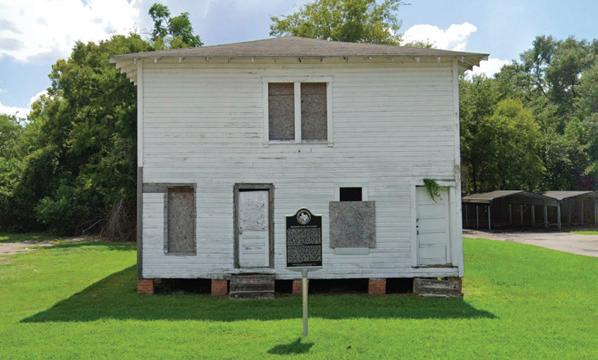
The Old Masonic Hall in Lufkin was built in 1901. The lodge was used by various organizations over the years, including the Odd Fellows, Order of Elks, Free Masons, Eastern Stars, Heroines of Jericho and East Texas Undertaking Co. The structure was abandoned in 1951, and fell victim to neglect. Today the lodge building is owned by Sarah’s Hope Charitable and Educational Foundation, and will receive a $75,000 grant through Preservation Texas’s Rural African-American Heritage Grants Program.

ADDRESS 523 W. 3rd Street, Texarkana
DESIGNATION NRHP Eligible
CONDITION Fair
OWNER Jamison Heirs
RESOURCE TYPE Commercial
YEAR LISTED 2022

Medical Doctors G.U. Jamison Sr., W.T. Thompson, and A.W. Weatherford built the Jamison-ThompsonWeatherford building in 1930. As Texarkana’s first African-American business and professional office building, it was used by dentists, doctors and lawyers, as well as the Black Chamber of Commerce, the Colored Library and the Negro Urban League. The building remained in use by various businesses until the 1980s, when it became vacant. Dr. Jamison’s heirs are now working to rehabilitate the building, which will receive a $50,000 grant through Preservation Texas’s Rural African-American Heritage Grants Program.
EPPERSON’S FERRY
ADDRESS Sulphur Fork of Red River, near Maud
DESIGNATION None
CONDITION Threatened
OWNER U.S. Army Corps of Engineers
RESOURCE TYPE Archaeological Site
YEAR LISTED 2022
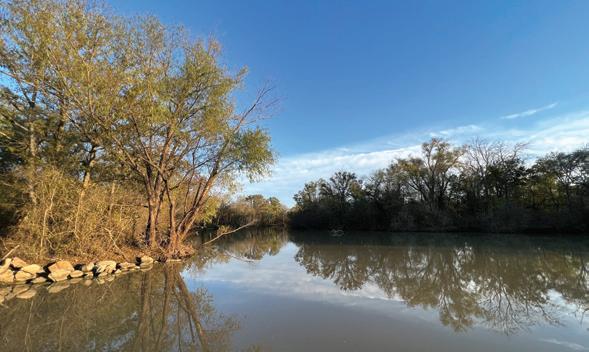
In 1835, Mark Epperson built the first ferry along Trammel’s Trace to cross the Sulphur Fork of the Red River. Epperson operated the ferry for four decades until it was eventually replaced by a bridge. The site is a short distance upriver from Wright Patman Lake. The U.S. Army Corps of Engineers (USACE) has approved a plan to raise the lake’s water level by 8 feet in order to meet water demands in the DFW Metroplex, which will result in significant flooding of this archaeological site. Preservation Texas is engaging with USACE as a Section 106 Consulting Party to ensure that the threat to the Epperson’s Ferry site is mitigated.
ADDRESS
201 Main St, Bloomburg
DESIGNATION None
CONDITION Poor
OWNER Private
RESOURCE TYPE Commercial, Bank
YEAR LISTED 2005
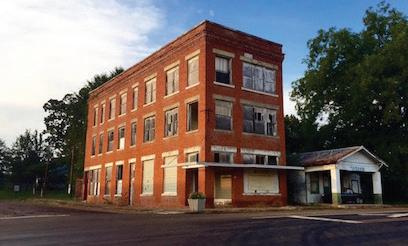
In 1918, Bloomburg State Bank moved into this three-story building, which remains the tallest building in Cass County. At one time, the building also housed the telephone office and a masonic lodge. Vacant since the early 1980s, the building continues to deteriorate. This bank building represents the threat faced by small town banks statewide. Mid-20th century suburbanization and demand for drive-through banking led many banks to abandon their historic buildings, which often become the victims of neglect.

ADDRESS 121 West Rush St, Linden
DESIGNATION NRHP Eligible
CONDITION Poor
OWNER Preservation Texas
RESOURCE TYPE Municipal, Fire Station
YEAR LISTED 2016
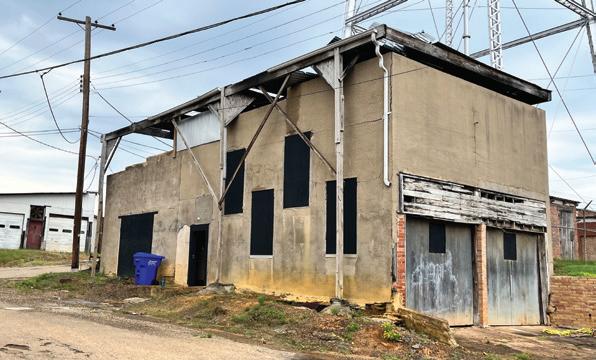
Linden’s Volunteer Fire Department was organized in 1935, and the fire station was built in 1939 as a complement to Linden’s WPA-sponsored Sanitary Waterworks - one of the first two such infrastructure projects approved in the state of Texas. The building functioned as a fire station until 1961. Years of neglect resulted in deterioration, loss of windows and a portion of the roof, and interior damage caused by water infiltration. Upon threat of demolition, Preservation Texas purchased the building from the City of Linden in 2022 so that it can be rehabilitated. See page 21 for more information.
ADDRESS 207 Grubbs Street, Linden
DESIGNATION NRHP Eligible
CONDITION Fair
OWNER Macedonia Missionary Baptist Church
RESOURCE TYPE Institutional, School
YEAR LISTED 2022
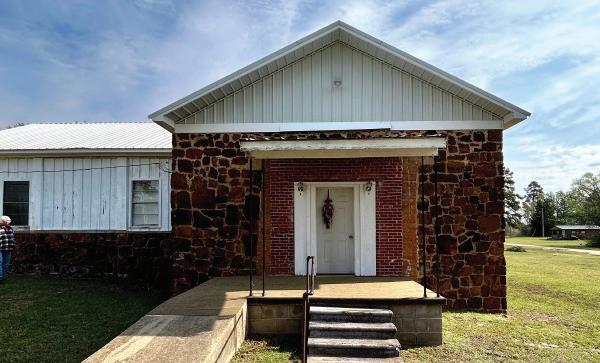
The Macedonia Rock School building was constructed in 1942 to serve as a shop and home economics building for Linden’s Colored School. Since that time, the building has also served as a gathering place for a wide array of activities, including a Masonic Lodge Hall, home of Boy Scout Troop 108, home of a 4-H Club, an elementary and middle school, a community center, and a church sanctuary. The Macedonia School building suffers from deterioration and aging, but its advocates aim to repair and bring the building back to structural safety, reliability, and dependability for the community’s use. The Macedonia School will receive a $50,000 grant through Preservation Texas’s Rural African-American Heritage Grants Program.
ADDRESS Sister Grove Creek, Collin County
DESIGNATION None
CONDITION Fair
OWNER TxDOT
RESOURCE TYPE Bridges
YEAR LISTED 2005
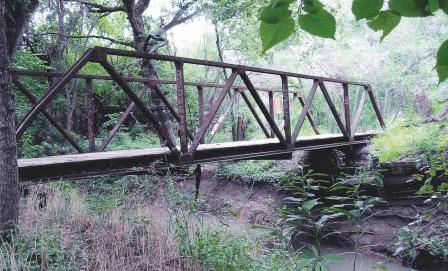
The iron bridges of Collin County are the last one-lane, World War I era, iron open-truss bridges to cross Sister Grove Creek. Each bridge is 60 feet long and has no builders’ plates and no prefabricated and riveted assemblies. All fastenings and joints are made by square headed nuts and bolts. The bridges serve the last undeveloped areas in Collin County and represent the use of local raw materials and labor in construction.

FAIR PARK
ADDRESS 3809 Grand Ave, Dallas
DESIGNATION NRHP, RTHL, SAL
CONDITION Fair
OWNER City of Dallas
RESOURCE TYPE Cultural Landscape
YEAR LISTED 2017

Established as an 80-acre fairground for the 1886 State Fair, the site officially became Dallas’ second public park in 1904. The first formal plan for the park was designed by Landscape architect George Kessler, who was influenced by the City Beautiful Movement. In preparation for the Texas Centennial Exposition in 1936, architects George Dahl and Paul Cret transformed the park into an Art Deco showcase. While the exposition’s buildings were meant to be temporary, several survive today in various conditions.
ADDRESS Various schools, Dallas
DESIGNATION Various
CONDITION Good
OWNER Dallas ISD
RESOURCE TYPE Institutional, Schools
YEAR LISTED 2019

Dallas Independent School District (DISD) has released a proposed Strategic Facilities Plan calling for the demolition of nineteen schools, the majority of which are of historic-age, to be replaced with seventeen new schools. The schools proposed for demolition range in style from revivalist to mid-century, many designed by significant architects, scattered throughout Dallas. Preservation advocates in Dallas aim to decrease the number of historic schools recommended for demolition or to consider rehabilitation as an alternative.
ADDRESS 433 S Center St, Longview
DESIGNATION RTHL
CONDITION Good
OWNER Preservation Longview
RESOURCE TYPE Residence
YEAR LISTED 2009

Completed in 1872, this home was purchased by J.N. Campbell, the first Gregg County judge around 1895. Originally constructed in the Queen Anne style, the house was renovated in the early 1900s in the Neoclassical style. As the home of a prominent judge, it has hosted many Texas jurists as well as business and political leaders. In 2008, following years of neglect and a demolition order, the house was purchased by Preservation Longview. The organization is working toward restoring it to be used as a community venue and museum.

ADDRESS 2616 & 2620 MacArthur Street, Longview
DESIGNATION NRHP Eligible
CONDITION Fair
OWNER Komatsu
RESOURCE TYPE Residence
YEAR LISTED 2023

During the mid-century prefabricated housing boom, the industrial manufacturer R.G. LeTourneau invented the Tournalayer, a machine which would produce a concrete “house-a-day”. Initially used to create modernist housing for his employees, LeTourneau’s machine was later marketed and used all over the world. Two homes in Longview are among of the only remaining Tournalaid homes in the world. The homes are currently owned by Komatsu and are scheduled to be demolished in 2024 as part of the company’s plans to expand its manufacturing facilities. Efforts by the Machine-Built Architecture Conservancy are underway to relocate these two rare structures to a nearby site.
ADDRESS 2100 Warren Dr, Marshall
DESIGNATION NRHP Eligible
CONDITION Fair
OWNER Harrison County
RESOURCE TYPE Transportation
YEAR LISTED 2016

This multi-story terminal was designed by Shreveport-based architect Joseph P. Schierer and completed in 1953. The building displays cleanly articulated brick and rusticated limestone exterior cladding, flat roofs, banded glazing and strong horizontal lines. It was built on a site deeded to Harrison County by the City of Marshall in 1947 for the development of an aviation facility in accordance with the National Airport Plan. Deferred maintainence and a lack of funding for rehabilitation pose major threats to the building.
ADDRESS FM 1186, near Ponderosa Rd, between Gill and Horton
DESIGNATION None
CONDITION Poor
OWNER Harrison County
RESOURCE TYPE Institutional
YEAR LISTED 2004

Sabine Farms was one of 200 New Deal Resettlement Administration communities and one of only thirteen set aside for African Americans. It was the only African American Resettlement community west of the Mississippi. The Community Center once included a number of freestanding log structures, several of which survive in an advanced state of decay.

ADDRESS
803 N 4th St, Crockett
DESIGNATION NRHP
CONDITION Poor
OWNER The Mary Allen Museum of African American Art and History
BUILDING TYPE Institutional
YEAR LISTED 2007
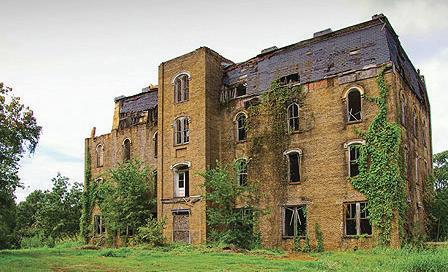
Mary Allen Hall was the 1887 administration building of the former Mary Allen Seminary. The four-story Second Empire-style brick building is all that remains of this school for African-American women built during the post-Reconstruction period. The Seminary was founded by the Presbyterian Board of Missions for Freedmen headquartered in Pittsburgh, Pennsylvania and later became Mary Allen College. It closed in 1972. Today, the Mary Allen Museum of African-American Art and History is seeking to restore Mary Allen Hall.
ADDRESS TX HWY 34 and FM 1388, Kaufman
DESIGNATION None
CONDITION Fair
OWNER Kaufman County
RESOURCE TYPE Institutional
YEAR LISTED 2007

The Poor Farm was established in 1883 by Kaufman County to provide housing for its poor and indigent population. It also provided barracks for jail inmates, housed an epidemic camp and, in 1931, was used in the Farm Demonstration Program. Originally over 408 acres, the farm operated into the 1970s. For the last 30 years, the Kaufman County Historical Commission has been working to preserve the site’s remaining 27 acres, various 19th and 20th century buildings, and vintage farm implements.
ADDRESS 21 Lamar Ave, Paris
DESIGNATION
Contributing to NRHP District
CONDITION Fair
OWNER City of Paris
BUILDING TYPE Theater
YEAR LISTED 2007

Designed by architect Jake Elder and constructed in 1937, the Grand was the largest theater in Paris for over fifty years, and its fly-loft was the tallest west of the Mississippi. A new theater was constructed in Paris in 1996, and the already deteriorating Grand closed. The building was later abandoned. Years of water infiltration, animal infestation and neglect caused the theater to deteriorate quickly. In 2019, the Grand Theater project was launched to raise the funds necessary to restore the building.

ADDRESS 111 N Walnut St, Jefferson
DESIGNATION None
CONDITION Poor
OWNER Private
BUILDING TYPE Commercial, Bank
YEAR LISTED 2008
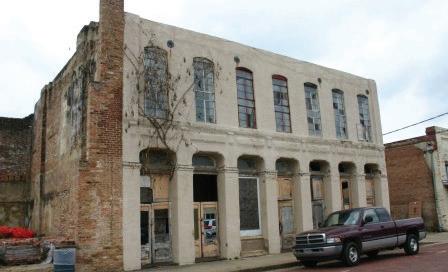
The Citizens Savings Bank building was constructed in 1871 during the commercial boom of Jefferson. The property was sold in 1897 and is currently owned by a private individual. The two-story commercial building has not been maintained and has been vacant for many years.
ADDRESS 720 Bois d’ Arc St, Nacogdoches
DESIGNATION None
CONDITION Good
OWNER African American Heritage Project
BUILDING TYPE Residence
YEAR LISTED 2014
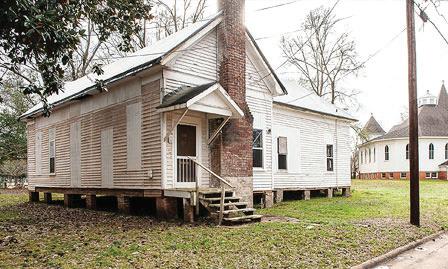
The Clay House, constructed circa 1905, is thought to have been designed by noted local architect Diedrich Rulfs. Built for local grocer Charlie Clay and his family, this structure is an important example of vernacular architecture in one of the most intact early 20th century African-American working class neighborhoods in Texas. The house was slated for demolition by the city in 2010 when the African American Heritage Project stepped in and purchased the property. An abbreviated historic structures report, funded by the Summerlee Foundation, was completed in 2020 and will guide the Clay House rehabilitation project.
FIRST INDEPENDENT BAPTIST CHURCH
ADDRESS 701 G. W. Jackson Avenue, Corsicana
DESIGNATION NRHP Eligible
CONDITION Fair
OWNER First Independent Baptist Church
BUILDING TYPE Church
YEAR LISTED 2022
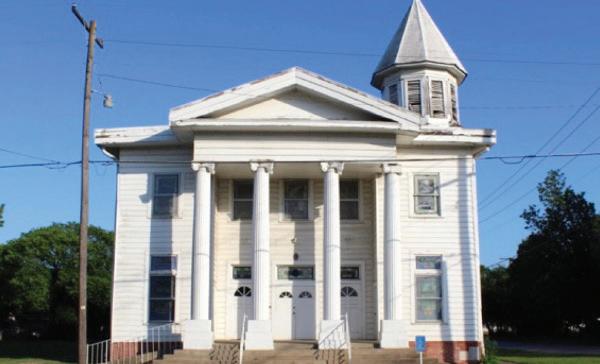
In 1868, a group of former slaves, led by Simon Perry, organized the second African Baptist Church in Corsicana. The present structure was completed in 1918, and the church’s name was changed to First Independent Baptist in 1929 to reflect the congregation’s independence from other religious groups. The church building remains in use by the congregation today, however it suffers from deferred maintenance. The First Independent Baptist Church will receive a $50,000 grant through Preservation Texas’s Rural African-American Heritage Grants Program.

ADDRESS
917 G.W. Jackson Avenue, Corsicana
DESIGNATION NRHP Eligible
CONDITION Poor
OWNER Meetinghouse Revival
BUILDING TYPE Church
YEAR LISTED 2022

The Wesley Chapel C.M.E. building was constructed in 1916 in the heart of Corsicana’s historically Black East Side Community. This simple, one-room wooden church, built in the Texas Vernacular Style, preserves the religious and architectural legacy of free and formerly enslaved Black Americans in rural Texas. It operated as a C.M.E. church until 1994. The building later served as Temple #330 of Church of the Living God Christian Workers Fellowship, but has been vacant since 2015. Today, Meetinghouse Revival is dedicated to the building’s rehabilitation. The Wesley Chapel will receive a $75,000 grant through Preservation Texas’s Rural African-American Heritage Grants Program.
ADDRESS
19447 F M 95 S, Mount Enterprise
DESIGNATION NRHP Eligible
CONDITION Poor
OWNER Concord High School Alumni Association
BUILDING TYPE Institutional, School
YEAR LISTED 2022

Built in 1925, the Concord Rosenwald School started as an eighth-grade school, and moved to twelve grades in 1941. Over the years, additional buildings were constructed on the property. The school conducted classes until 1971, when Concord Common School District merged with Henderson ISD. Today all of the school buildings have been moved or demolished, except for the Rosenwald building, which is suffering from neglect. The Concord High School Alumni Association plans to restore the building. The Concord Rosenwald School will receive a $75,000 grant through Preservation Texas’s Rural African-American Heritage Grants Program.
Preservation Texas has also included the following statewide themes on its Most Endangered Places list to encourage Texans to identify threatened structures in their own communities that relate to the theme:
• Barns
• Carpenter Gothic Churches
• Cemeteries
• Dams
• Dance Halls
• Gas Stations
• Historic Residential Wood Windows
• Historic Neighborhoods
• Historically Segregated MexicanAmerican Public Schools

• Log Buildings
• Mid-Century Modern Sacred Places
• Painted Advertising Signs aka “Ghost Signs”
• Residential Teardowns in Inner-City Neighborhoods
• Rural African-American Heritage Sites
• Small Town Bank Buildings
• Small Town Theaters and Opera Houses
• Urban National Register Districts
• Working Class Neighborhoods
789


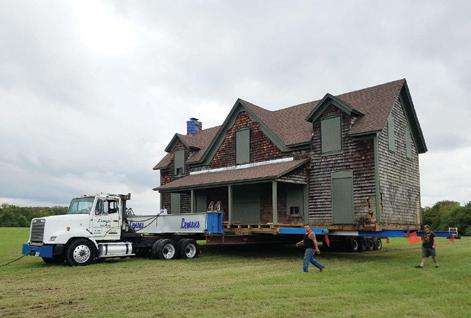
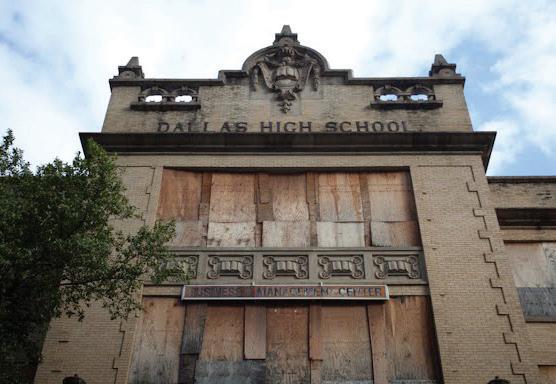

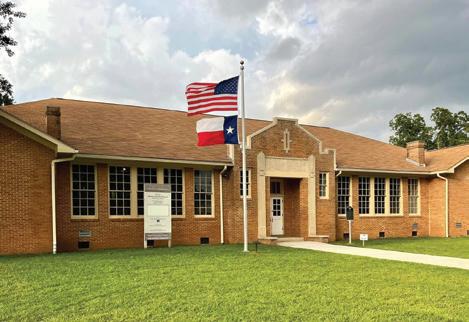
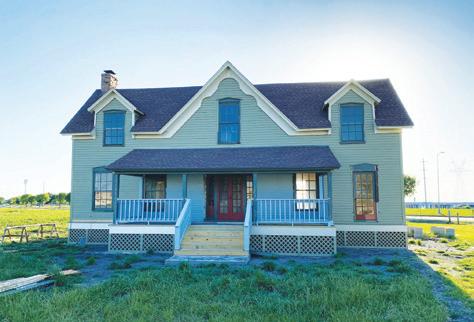
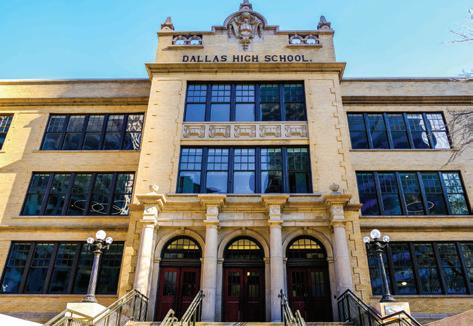


ELLIS COUNTY
WAXAHACHIE LODGE
441 Dr. MLK Jr. Blvd, Waxahachie
2011 Most Endangered Places List 2017 Honor Award
MARION COUNTY
JEFFERSON ORDINANCE MAGAZINE
Big Cypress Bayou, 500 ft. downstream of Jefferson boat launch, Jefferson
2014 Most Endangered Places List
JEFFERSON PLAYHOUSE
1860 N Market St, Jefferson
2005 Most Endangered Places List

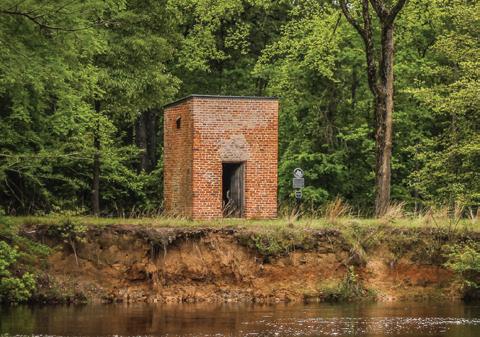
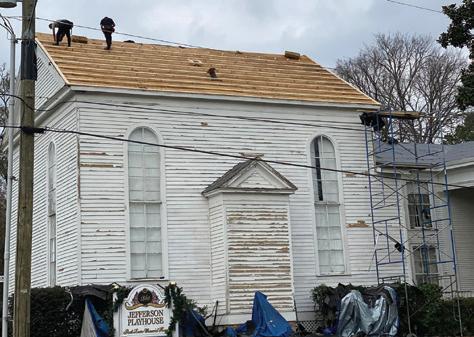
UNION MISSIONARY BAPTIST CHURCH
520 S. Houston St, Jefferson
2012 Most Endangered Places List
SAN AUGUSTINE
LEWIS RAILROAD HOTEL
500 W Columbia St, San Augustine
2012 Most Endangered Places List 2023 Honor Award
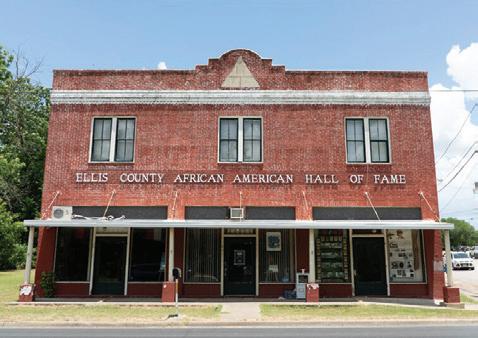

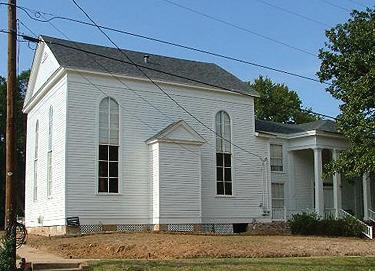
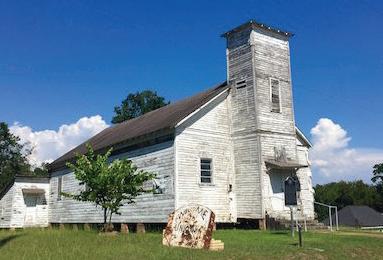
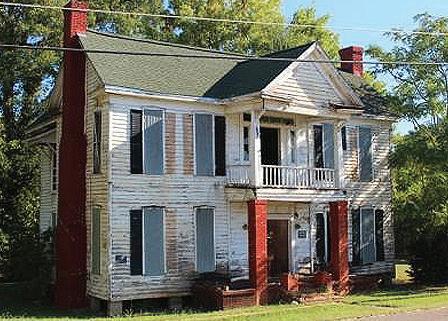

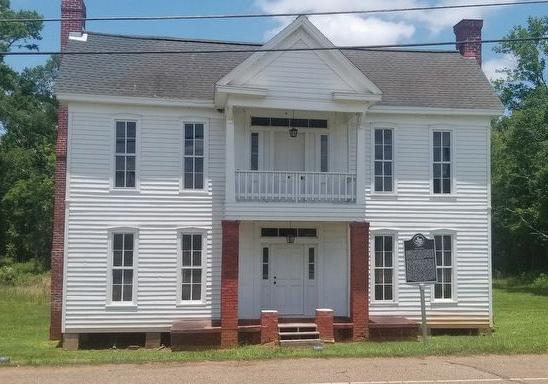

DALLAS COUNTY
GREAT NATIONAL LIFE INSURANCE BUILDING
6500 Harry Hines Blvd, Dallas
2016 Most Endangered Places List
Demolished 2018
LIVE STONE LODGE #152
Grand Prairie
2008 Most Endangered Places List
Demolished
GRAYSON COUNTY
OLD DENISON HIGH SCHOOL
700 Block of Main Street, Denison
2007 Most Endangered Places List
Demolished 2007

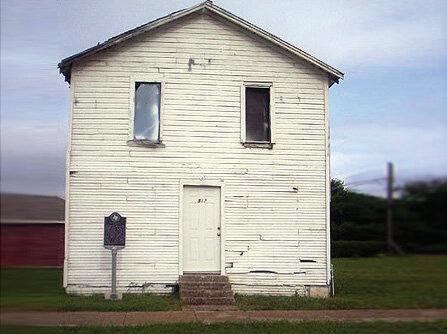
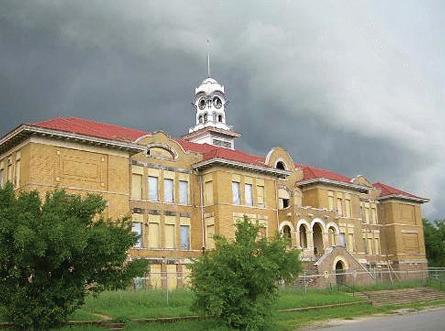
Visit PreservationTexas.org/MEP to learn more about Preservation Texas’s Most Endangered Places List program, and to explore all of the sites that have been included on the list since 2004.


In 2022, Preservation Texas’s Board of Directors agreed to move to a regional office model for the delivery of preservation education and technical assistance programs. Historic preservation is intensely local and site-specific, and regional offices will enable PT to have a more direct and sustained impact across the state.
To date, Preservation Texas has established a Central Texas office based in San Marcos, and a Northeast Texas office based in Tyler. Existing offices have been made possible by the support of the Burdine Johnson Foundation (Central Texas), the Dealey Family Foundation and the Summerlee Foundation (Northeast Texas). A West Texas Office based in El Paso is expected to open in early 2024. Additional regional offices will open as funding becomes available.
Conor Herterich was hired in January of 2023 as Preservation Texas’s Endangered Properties Manager and Northeast Texas Program Officer. Conor holds a masters degree in public history from Stephen F. Austin State University. He has a passion for hands-on preservation and learning about vernacular buildings and construction methods.
From 2018-2021, Conor worked for the city of Bloomington, Indiana as the Historic Preservation Program Manager where he facilitated local preservation ordinances and applied design review to hundreds of projects impacting historic buildings throughout twelve local historic districts. He worked in cultural resource management from 2021-2022 as an architectural historian, where he made numerous NRHP eligibility assessments and participated in drafting and implementing Programmatic and
Memorandum Agreements for projects involving adverse effects to culturally-significant properties.
Based in Tyler, Conor will serve as a first point of contact for members and stakeholders in the Northeast Texas region, and will also oversee our Rural African-American Heritage Grants Program and future Northeast Texas revolving fund projects.
Contact: conor@preservationtexas.org

• Sue Morris Lazara, Linden
• Charlene Orr, Kaufman
• Ron Siebler, Dallas
Learn more about Preservation Texas’s board of directors at PreservationTexas.org/Board.

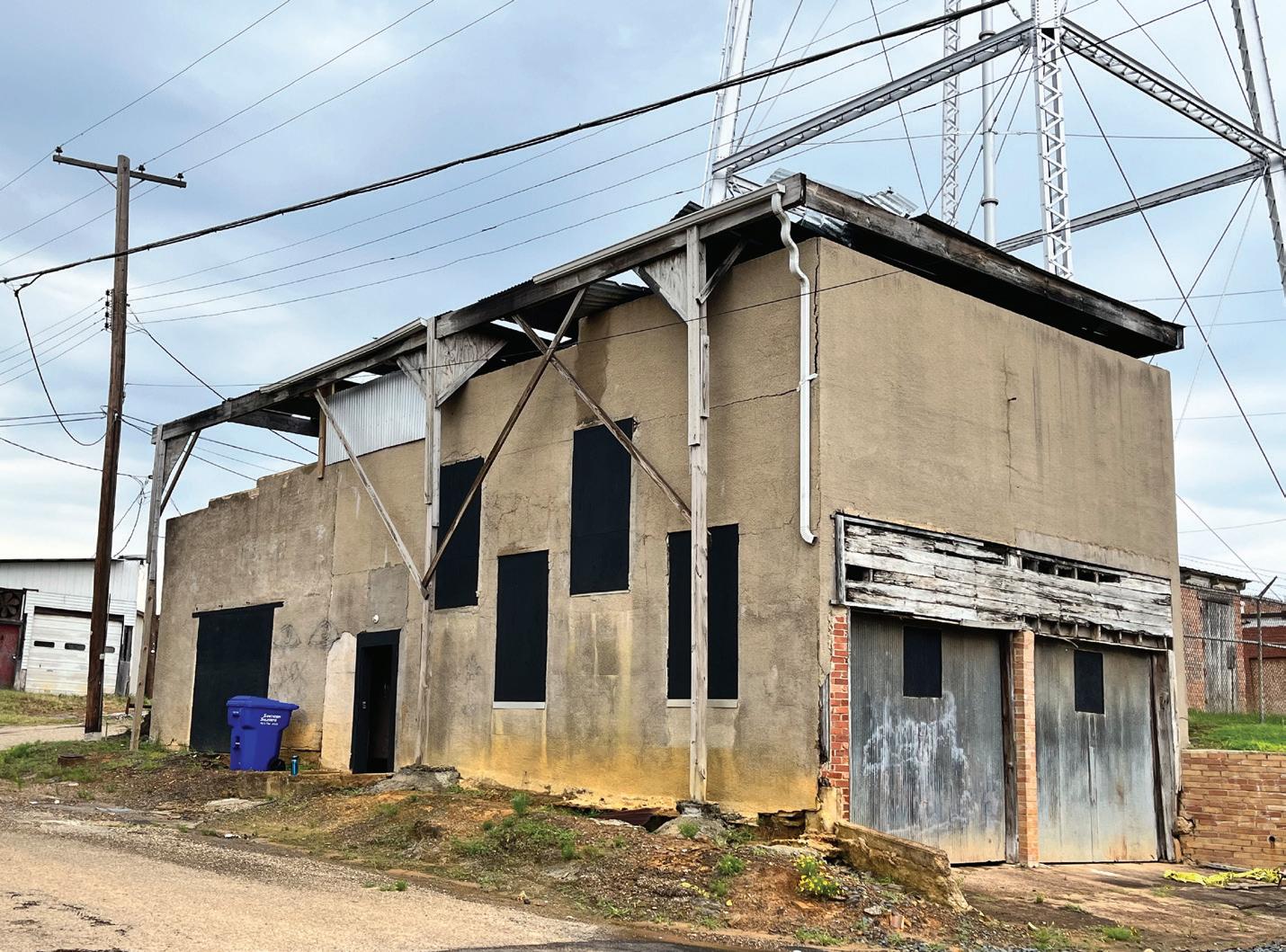
The Northeast Texas regional office is piloting an initiative to directly invest in threatened historic structures. The Linden Fire Station is the first project that Preservation Texas is undertaking in the region.
The Linden Fire Station was built in 1939 to house a fire truck and a new volunteer fire department. It was later altered and expanded to make room for additional vehicles, and remained in use as a fire station until 1961. The building was included on Preservation Texas’s 2016 Most Endangered Places List, and purchased in 2022 by Preservation Texas from the City of Linden so that it can be rehabilitated.
Since acquiring the building, Preservation Texas has engaged a preservation engineer, Steve Lucy of JQ Engineering to assess the building so that plans can be made for the replacement of its roof and overall stabilization of the structure. This preliminary work has been made possible by a generous donation from Nassau Holding LLC, PT board member Sue Morris Lazara, and an anonymous donor.
Through its Endangered Properties Committee, Preservation Texas will oversee the preservation of this building and consider opportunities for future restoration projects. Property owners who are interested in potentially donating a threatened structure to Preservation Texas should contact Conor Herterich at conor@preservationtexas. org .

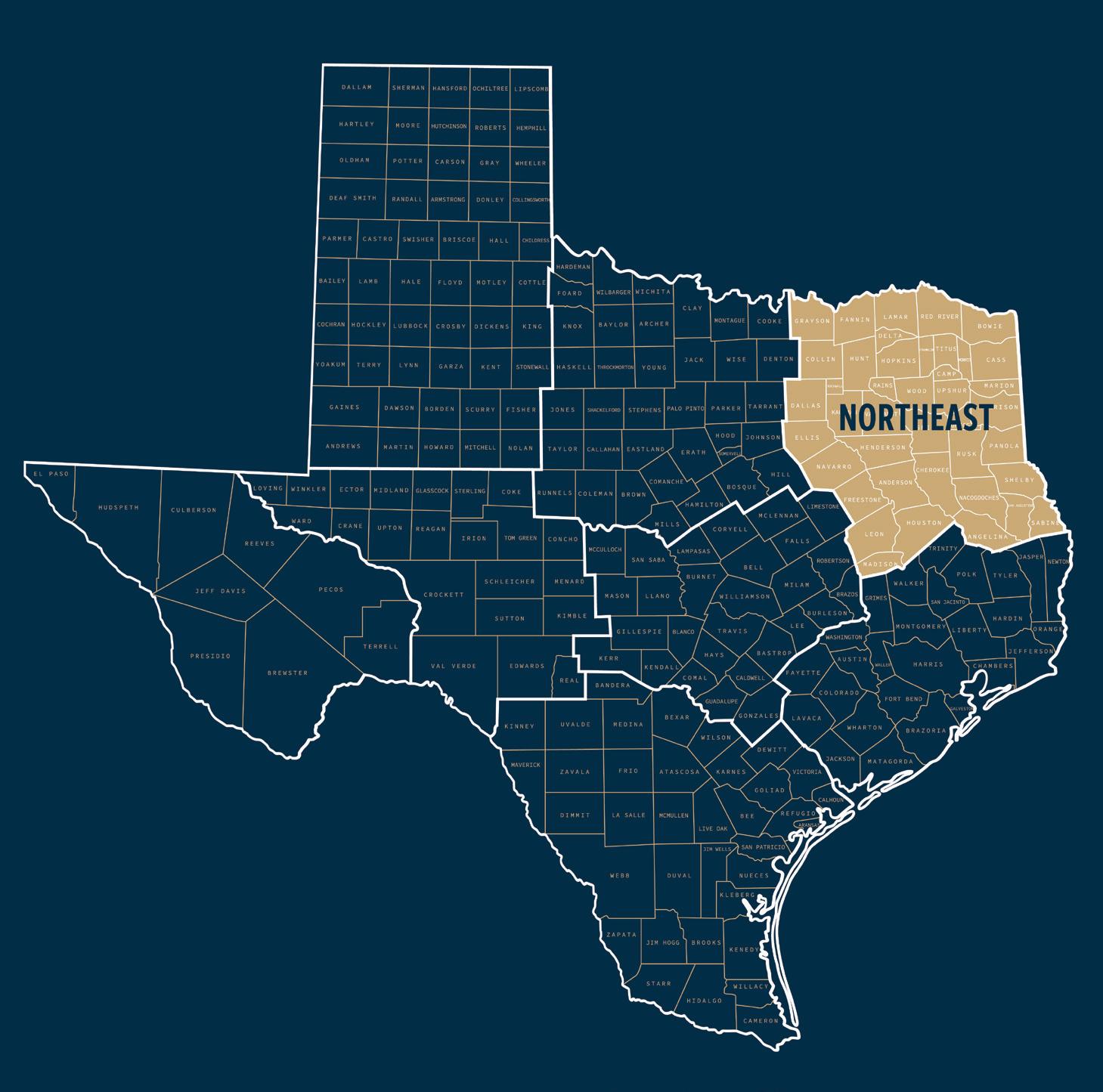
This publication has been made possible by the generous support of




